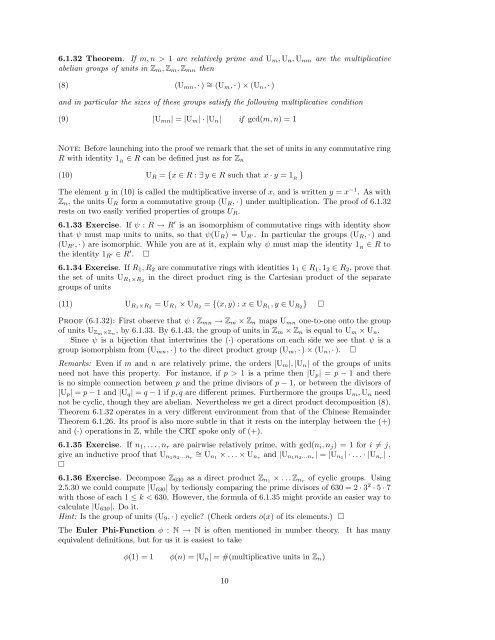Algebra I: Section 6. The structure of groups. 6.1 Direct products of ...
Algebra I: Section 6. The structure of groups. 6.1 Direct products of ...
Algebra I: Section 6. The structure of groups. 6.1 Direct products of ...
You also want an ePaper? Increase the reach of your titles
YUMPU automatically turns print PDFs into web optimized ePapers that Google loves.
<strong>6.</strong>1.32 <strong>The</strong>orem. If m, n > 1 are relatively prime and Um, Un, Umn are the multiplicative<br />
abelian <strong>groups</strong> <strong>of</strong> units in Zm, Zm, Zmn then<br />
(8) (Umn, · ) ∼ = (Um, · ) × (Un, · )<br />
and in particular the sizes <strong>of</strong> these <strong>groups</strong> satisfy the following multiplicative condition<br />
(9) |Umn| = |Um| · |Un| if gcd(m, n) = 1<br />
Note: Before launching into the pro<strong>of</strong> we remark that the set <strong>of</strong> units in any commutative ring<br />
R with identity 1 R ∈ R can be defined just as for Zn<br />
(10) UR = {x ∈ R : ∃ y ∈ R such that x · y = 1 R }<br />
<strong>The</strong> element y in (10) is called the multiplicative inverse <strong>of</strong> x, and is written y = x −1 . As with<br />
Zn, the units UR form a commutative group (UR, · ) under multiplication. <strong>The</strong> pro<strong>of</strong> <strong>of</strong> <strong>6.</strong>1.32<br />
rests on two easily verified properties <strong>of</strong> <strong>groups</strong> UR.<br />
<strong>6.</strong>1.33 Exercise. If ψ : R → R ′ is an isomorphism <strong>of</strong> commutative rings with identity show<br />
that ψ must map units to units, so that ψ(UR) = UR ′. In particular the <strong>groups</strong> (UR, · ) and<br />
(UR ′, · ) are isomorphic. While you are at it, explain why ψ must map the identity 1 ∈ R to<br />
R<br />
the identity 1R ′ ∈ R′ . �<br />
<strong>6.</strong>1.34 Exercise. If R1, R2 are commutative rings with identities 11 ∈ R1, 12 ∈ R2, prove that<br />
the set <strong>of</strong> units UR1×R2 in the direct product ring is the Cartesian product <strong>of</strong> the separate<br />
<strong>groups</strong> <strong>of</strong> units<br />
(11) UR1×R2 = UR1 × UR2 = {(x, y) : x ∈ UR1, y ∈ UR2} �<br />
Pro<strong>of</strong> (<strong>6.</strong>1.32): First observe that ψ : Zmn → Zm × Zn maps Umn one-to-one onto the group<br />
<strong>of</strong> units UZm×Zn, by <strong>6.</strong>1.33. By <strong>6.</strong>1.43, the group <strong>of</strong> units in Zm × Zn is equal to Um × Un.<br />
Since ψ is a bijection that intertwines the (·) operations on each side we see that ψ is a<br />
group isomorphism from (Umn, · ) to the direct product group (Um, · ) × (Un, · ). �<br />
Remarks: Even if m and n are relatively prime, the orders |Um|, |Un| <strong>of</strong> the <strong>groups</strong> <strong>of</strong> units<br />
need not have this property. For instance, if p > 1 is a prime then |Up| = p − 1 and there<br />
is no simple connection between p and the prime divisors <strong>of</strong> p − 1, or between the divisors <strong>of</strong><br />
|Up| = p − 1 and |Uq| = q − 1 if p, q are different primes. Furthermore the <strong>groups</strong> Um, Un need<br />
not be cyclic, though they are abelian. Nevertheless we get a direct product decomposition (8).<br />
<strong>The</strong>orem <strong>6.</strong>1.32 operates in a very different environment from that <strong>of</strong> the Chinese Remainder<br />
<strong>The</strong>orem <strong>6.</strong>1.2<strong>6.</strong> Its pro<strong>of</strong> is also more subtle in that it rests on the interplay between the (+)<br />
and (·) operations in Z, while the CRT spoke only <strong>of</strong> (+).<br />
<strong>6.</strong>1.35 Exercise. If n1, . . . , nr are pairwise relatively prime, with gcd(ni, nj) = 1 for i �= j,<br />
give an inductive pro<strong>of</strong> that ∼= Un1n2...nr Un1 × . . . × Unr and |Un1n2...nr| = |Un1| · . . . · |Unr| .<br />
�<br />
<strong>6.</strong>1.36 Exercise. Decompose Z630 as a direct product Zn1 × . . . Znr <strong>of</strong> cyclic <strong>groups</strong>. Using<br />
2.5.30 we could compute |U630| by tediously comparing the prime divisors <strong>of</strong> 630 = 2 · 3 2 · 5 · 7<br />
with those <strong>of</strong> each 1 ≤ k < 630. However, the formula <strong>of</strong> <strong>6.</strong>1.35 might provide an easier way to<br />
calculate |U630|. Do it.<br />
Hint: Is the group <strong>of</strong> units (U9, · ) cyclic? (Check orders o(x) <strong>of</strong> its elements.) �<br />
<strong>The</strong> Euler Phi-Function φ : N → N is <strong>of</strong>ten mentioned in number theory. It has many<br />
equivalent definitions, but for us it is easiest to take<br />
φ(1) = 1 φ(n) = |Un| = #(multiplicative units in Zn)<br />
10

















